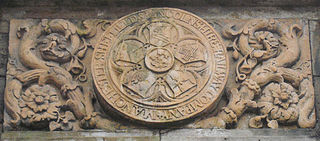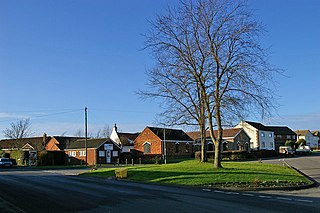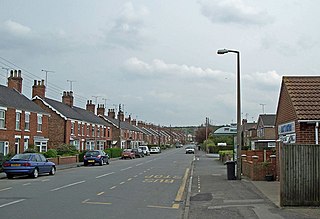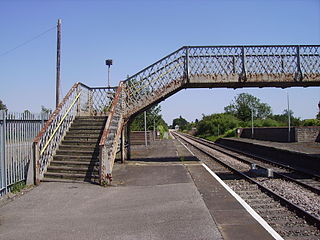
The Manchester, Sheffield and Lincolnshire Railway (MS&LR) was formed in 1847 when the Sheffield, Ashton-under-Lyne and Manchester Railway joined with authorised but unbuilt railway companies, forming a proposed network from Manchester to Grimsby. It pursued a policy of expanding its area of influence, especially in reaching west to Liverpool, which it ultimately did through the medium of the Cheshire Lines Committee network in joint partnership with the Great Northern Railway and the Midland Railway.

South Killingholme is a village and civil parish in North Lincolnshire, England. The population of the civil parish at the 2011 census was 1,108.

The Sheffield–Lincoln line is a railway line in England. It runs from Sheffield to Lincoln via Worksop, Retford and Gainsborough Lea Road. The route comprises the main line of the former Manchester, Sheffield and Lincolnshire Railway (MS&LR), to Gainsborough Trent Junction, where it then follows the former Great Northern and Great Eastern Joint Railway (GNGEJR) to Lincoln Central. The former MS&LR main line continues from Trent Junction to Wrawby Junction, Barnetby, much of it now single line, where it then runs to Cleethorpes.

Barnetby railway station serves the village of Barnetby-le-Wold in North Lincolnshire, England. It is operated by TransPennine Express, with East Midlands Railway and Northern Trains also serving the station.

Cleethorpes railway station is a railway station serving the seaside town of Cleethorpes in Lincolnshire, England. The station is managed by TransPennine Express, with East Midlands Railway and Northern Services also using the station. The station is the terminus and start of multiple services.

The Barton line is a railway line in North and North East Lincolnshire, England. It runs from Barton-upon-Humber south east to Cleethorpes and was designated by the Department for Transport as a community rail line in February 2007. Barton station is near to the Humber Bridge. It is situated on the south bank of the Humber Estuary.

Barnetby le Wold is a village and civil parish in North Lincolnshire, Lincolnshire, England, located between Brigg and Immingham. The village is also near Barton-upon-Humber. The population of the parish in the 2001 census was 1,593. This increased by 148 to 1,741 in the 2011 census.

Barton-on-Humber railway station serves the town of Barton-upon-Humber in North Lincolnshire, England.

Ulceby railway station serves the village of Ulceby in North East Lincolnshire, England. It was built by the Great Grimsby and Sheffield Junction Railway in 1848 and is located at Ulceby Skitter.
The Grimsby District Light Railway (GDLR) was one of three standard gauge railways, all part of the Great Central Railway, promoted by the latter to connect the wider world to Immingham Dock which it built in the early Twentieth Century on an almost uninhabited, greenfield site on the south bank of the Humber, England.

The Grimsby & Immingham Electric Railway (G&IER) was an electric light railway, primarily for passenger traffic, linking Great Grimsby with the Port of Immingham in Lincolnshire, England. The line was built by the Great Central Railway (GCR), was absorbed by the London & North Eastern Railway (LNER) in 1923, and became part of the Eastern Region of British Railways. It ran mainly on reserved track.

Brigg railway station serves the town of Brigg in North Lincolnshire, England. It opened on 1 November 1848. It is managed by Northern Trains, who also operate all passenger trains serving it.

Immingham Dock railway station served the dock at Immingham, Lincolnshire, England.

New Holland Pier railway station is a former railway terminus in North Lincolnshire, England. It stood at the seaward end of the New Holland Pier, which juts 1,375 feet (419 m) northwards into the Humber estuary at the village of New Holland. Its purpose was to enable railway passengers, vehicles and goods to transfer to and from ferries plying between New Holland and Hull.

The Port of Immingham, also known as Immingham Dock, is a major port on the east coast of England, located on the south bank of the Humber Estuary in the town of Immingham, Lincolnshire. In 2019, the Port of Grimsby & Immingham was the largest port in the United Kingdom by tonnage with 54.1 million tonnes of cargo passing through that year.

Corporation Pier station was the Manchester, Sheffield and Lincolnshire Railway's booking office for their ferry service between Corporation Pier, Hull and New Holland Pier in Lincolnshire. It was not rail connected, but served as a ticket office and waiting room for the Humber Ferry.
The Barton and Immingham Light Railway is a railway line in North Lincolnshire and North East Lincolnshire, Lincolnshire, England. It ran from a junction at Goxhill to Immingham Dock. Another spur runs from Immingham Dock to Ulceby. It was later absorbed by the Great Central Railway and later, on grouping, it passed to the London and North Eastern Railway. The railway is used for freight traffic to the ports at Immingham. The section from Goxhill to North Killingholme was mothballed and lifted. The track is still in situ but now overgrown and out of use.

The South Humberside Main Line runs from Doncaster on the East Coast Main Line to Thorne where it diverges from the Sheffield to Hull Line. It then runs eastwards to Scunthorpe and the Humber ports of Immingham and Grimsby, with the coastal resort of Cleethorpes as terminus.
Immingham Western Jetty railway station was the first railway station which served the dock in Immingham, Lincolnshire, England. It was replaced by Immingham Dock.

New Holland Town railway station is a former railway station in the village of New Holland in North Lincolnshire, England. It stood at the landward end of the pier, whilst the purpose of Pier station, which juts 1,375 feet (419 m) northwards into the Humber estuary, was to enable railway passengers and goods to transfer to and from ferries plying between New Holland and Hull. New Holland Town station's purpose was for more conventional use by the local community.
















